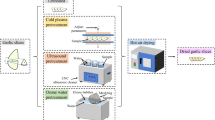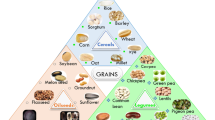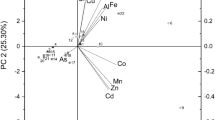Abstract
The effects were investigated of two different drying treatments (oven- andfreeze-drying) on the proximate composition, amino acid profile and somephysico-chemical properties of three subtropical brown seaweeds, Sargassum hemiphyllum, S. henslowianum and S. patens. Therewere significant differences (p < 0.05, two-way ANOVA,Tukey-HSD) in the ash, crude lipid and moisture contents of the threespecies treated by the two drying methods. The amount of total aminoacids in the oven-dried seaweed samples was significantly (p <0.05, two-way ANOVA, Tukey-HSD) lower than that of the freeze-driedones. However, there were no significant differences on the amount oftotal essential amino acids and individual amino acid between the oven- andfreeze-dried brown seaweeds. Physico-chemical properties includingswelling, water holding and oil holding capacity of the freeze-dried Sargassum species were significantly (p < 0.05, two-wayANOVA, Tukey-HSD) higher than those of the oven-dried seaweedsamples. This indicated that freeze-dried seaweeds had greater potential tobe used as food ingredients in formulated food products than oven-driedones.
Similar content being viewed by others
References
Anderson K (1996) Other preservation methods. In Arthey D, Dennis, C (eds), Vegetable Processing, Blackie Academic and Professional, UK, pp. 154-159.
AOAC (1995) Official Methods of Analysis. Association of Official Analytical Chemists 16th edition, Washington, D.C., USA.
Behairy AKA, El-Sayed MM (1983) Biochemical composition of some marine brown algae from Jeddah Coast, Saudi Arabia. Indian J. mar. Sci. 12: 200-201.
Caprez A, Arrigoni E, Amado R, Neukom, H (1986) Influence of different types of thermal treatment on the chemical composition and physical properties of wheat bran. J. Cereal Sci. 4: 233-239.
Carrillo S, Castro MI, Perez-Gil F, Rosales E, Manzano RE (1992) The seaweed (Sargassum sinicola Setchell & Gardner) as an alternative for animal feeding. Cuban J. agric. Sci. 26: 177-181.
Chan CCJ, Cheung PCK, Ang PO Jr (1997) Comparative studies on the effect of three drying methods on the nutritional composition of seaweed Sargassum hemiphyllum (Turn.) C. Ag. J. agric. Food Chem. 45: 3056-3059.
Chou DH, Morr CV (1979) Protein-water interactions and functional properties. J. Am. Oil Chem. Soc. 56: 53A-62A.
Darcy-Vrillon B (1993) Nutritional aspects of the developing use of marine macroalgae for the human food industry. Int. J. Food Sci. Nutr. 44: 23-35.
Fellows P (1988) Food Processing Technology Principal and Practice. Ellis Horwood Ltd., London, pp. 304-313.
Fleurence J (1999) Seaweed proteins: Biochemical, nutritional aspects and potential uses. Trends Food Sci. Technol. 10: 25-28.
Fleurence J, Le Coeur C, Mabeau S, Maurice M, Landrein A (1995) Comparison of different extractive procedures for proteins from the edible seaweeds Ulva rigida and Ulva rotundata. J. appl. Phycol. 7: 577-582.
Fleury N, Lahaye M (1991) Chemical and physico-chemical characterization of fibers from Laminaria digitata (Kombu Breton): A physiological approach. J. Sci. Food Agric. 55: 389-400.
Gehrke CW, Wall LL, Absheer JS, Kaiser FE, Zumwalt RW (1985) Sample preparation for chromatography of amino acids: acid hydrolysis of proteins. J. Assoc. Off. Anal. Chem. 68: 811-821.
Goñi I, Martin-Carrón N (1998) In vitro fermentation and hydration properties of commercial dietary fiber-rich supplements. Nutr. Res. 18: 1077-1089.
Grigelmo-Miguel N, Gorinstein S, Martin-Belloso O (1999) Characterization of peach dietary fiber concentrate as a food ingredient. Food Chem. 65: 175-181.
Grigelmo-Miguel N, Martin-Belloso O (1999) Characterization of dietary fiber from orange juice extraction. Food Res. Inter. 31: 355-361.
Hanisak MD, Samuel MA (1987) Growth rates in culture of several species of Sargassum from Florida, USA. Hydrobiologia 151/152: 399-404.
Ho YB (1988) Metal levels in three intertidal macroalgae in Hong Kong waters. Aquat. Bot. 29: 367-372.
Hodgkiss IJ, Lee KY (1983) Hong Kong Seaweeds. The Urban Council of Hong Kong, Hong Kong, 1-4, 14, 102-103 pp.
Hurtado AQ, Ragaza AR (1999) Sargassum Studies in Currimao, Ilocos Norte, Northern Philippines I. Seasonal variations in the biomass of Sargassum carpophyllum J. Agardh, Sargassum ilicifolium (Turner) C. Agardh and Sargassum siliquosum J. Agardh (Phaeophyta, Sargassaceae). Bot. mar. 42: 321-325.
Ito K, Hori K (1989) Seaweed: Chemical composition and potential food uses. Food Rev. Int. 5: 101-144.
Jensen A (1993) Present and future needs for algae and algal products. Hydrobiologia 260/261: 15-23.
Jordan P, Vilter H (1991) Extraction of proteins from material rich in anionic mucilages: Partition and fractionation of vanadatedependent bromoperoxidases from the brown algae Laminaria digitata and L. saccharina in aqueous polymer two-phase system. Biochem. biophys. Acta. 1073: 98-106.
Kaehler S, Kennish R (1996) Summer and winter comparisons in the nutrition value of marine marcoalgae from Hong Kong. Bot. mar. 39: 11-17.
Kinsella JE (1976) Functional properties of protein in foods: A survey. J. Food Sci. Nutr. 7: 219-280.
Kuniak L, Marchessault RH (1972) Study of crossing-linking reaction between epichorhydrin and starch. Starke 4: 110-116.
Mabeau S, Cavaloc E, Fleurence J, Lahaye M (1992) New seaweed based ingredients for the food industry. Int. Food Ingred. 3: 38-45.
Mabeau S, Fleurence J (1993) Seaweed in food products: biochemical and nutritional aspects. Trends Food Sci. Technol. 4: 103-107.
Naylor J (1976) Production, Trade and Utilization of Seaweeds and Seaweed Products. In FAO Fisheries Technical Paper No. 159. Food and Agriculture Organization of United Nations, Rome, Italy, pp. 1-71.
Norziah MH, Ching CY (2000) Nutritional composition of edible seaweed Gracilaria changgi. Food Chem. 68: 69-76.
Portugal TR, Ladines EO, Ardena SS, Resurreccion L, Medina CR, Matibag PM (1983) Nutritive value of some Philippine seaweeds part II: proximate, amino acids and vitamin composition. Philipp. J. Nutr. Oct-Dec.: 166-172.
Prosky L, Asp NG, Schweizer TF, Devries J, Furda, I (1988) Determination of insoluble, soluble and total dietary fiber in food products: Interlaboratory study. J. Am. Anal. Chem. 71: 1017-1023.
Prosky L, Asp NG, Schweizer TF, Devries J, Furda I (1992) Determination of insoluble and soluble dietary fiber in foods and food products: Interlaboratory study. J. Am. Anal. Chem. 75: 360-367.
Qasim R (1991) Amino acids composition of some seaweeds. Pakistan J. pharm. Sci. 4: 49-54.
Ragaza AR, Hurtado AQ (1999) Sargassum Studies in Currimao, Ilocos Norte, Northern Philippines II. Seasonal variations in the alginate yield and viscosity of Sargassum carpophyllum J. Agardh, Sargassum ilicifolium (Turner) C. Agardh and Sargassum siliquosum J. Agardh (Phaepphyta, Sargassaceae). Bot. mar. 42: 327-331.
Robertson JA, Eastwood MA (1981) An examination of factors, which may affect the water-holding capacity of dietary fiber. Br. J. Nutr. 45: 83-88.
Robledo D, Pelegrin YF (1997) Chemical and mineral composition of six potentially edible seaweed species of Yucatán. Bot. mar. 40: 301-306.
SPSS Inc. (1999) SPSS© Base 9.0 Application Guide. SPSS Inc., Chicago.
Suzuki T, Ohsugi Y, Yoshie Y, Shirai T, Hirano T (1996) Dietary fiber content, water holding capacity and binding capacity of seaweeds. Fish. Sci. 62: 454-461.
Thomas PC, Subbaramaiah K (1991) Seasonal variations in growth, reproduction, alginic acids, mannitiol, iodine and ash contents of brown alga Sargasum wightii. Ind. J. mar. Sci. 20: 169-175.
Trono GC, Jr, Montaño NE, Tolentino GL (1994) Seasonality of alginates yield and viscosity of five Sargassum species in Balinao, Pangasinan. Proc. Nat. Symp. Mar. Sci. 2: 149.
Tseng CK (1984) Phycological research in the development of the Chinese seaweed industry. Hydrobiologia. 116/117: 7-18.
Tseng CK, Chang CF (1984). Chinese seaweeds in herbal medicine. Hydrobiologia 116/117: 152-154.
Tseng CK, Yoshida T, Chiang YM (1985) East Asiatic species of Sargassum sugenus Bactrophycus J. Agardh (Sargassaceas, Fucales), with keys to the sections and species. In Abbott IA, Norris JN (eds), Taxonomy of Economic Seaweeds, California Sea Grant Program, University of California, CA, pp. 1-14.
Voutsinas LP, Nakai S (1983) A simple turbidimetric method for determining the fat binding capacity of proteins. J. Agric. Food Chem. 31: 58-61.
Wang WL, Chiang YM (1994) Potential economic seaweeds of Hengchun Peninsula, Taiwan. Econ. Bot. 48: 182-189.
Wong KH, Cheung PC (2001) Influence of drying treatment on three Sargassum species 2: Protein extractability, in vitro protein digestibility and amino acid profile of protein concentrates. J appl. Phycol. 13: 51-58.
Zemke-White WL, Ohno M (1999) World seaweed utilization: An end-of-century summary. J. appl. Phycol. 11: 369-376.
Author information
Authors and Affiliations
Rights and permissions
About this article
Cite this article
Wong, K., Cheung, P.C. Influence of drying treatment on three Sargassum species. Journal of Applied Phycology 13, 43–50 (2001). https://doi.org/10.1023/A:1008149215156
Issue Date:
DOI: https://doi.org/10.1023/A:1008149215156




